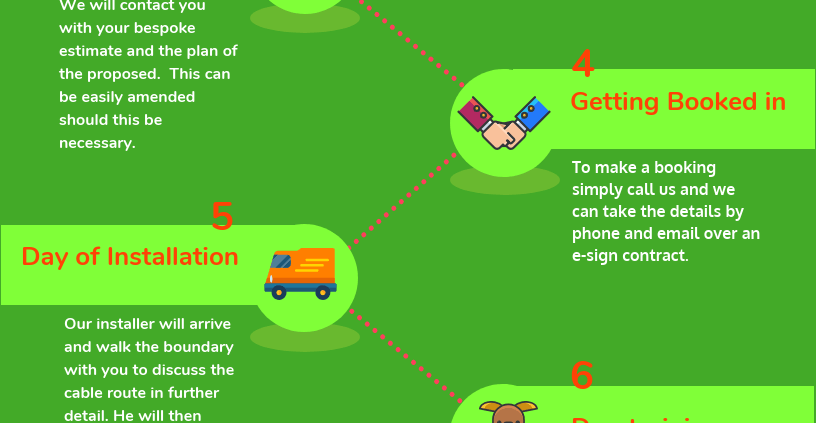Tag Archive for: underground dog fence
Electronic dog fence – FAQ’s for new customers
What You Need to Know About our Electronic Dog Fence: FAQ for New Customers
Booking a dog fence installation
Dog fence day
As a general rule, we commence the dog fence Installation will commence circa 07.30am! Interestingly this is to avoid rush-hour traffic and maximize daylight during the winter months. Our Installer will walk the boundary with your to fine-tune the electronic dog fence route. Once this has been agreed we should not need your attention again until we commence the dog fence training.
Our unique trenching equipment will bury the cable directly into the ground. We endeavour to bury boundary cables but if the terrain or an area is not suitable we can install cable above ground. Of course, the installation duration will vary depending on the size and the terrain but as a general rule, we will be ready to train your dog in the afternoon.
Electronic dog fence training
Now for the magic! We will not hook your dog up to the mains, we will not hurt your dog, we will train your dog using a recognised protocol. Actually, the training is very subtle and for some dogs, the scariest part is the temporary training flags. These little “flag” aliens can be quite scary to some dogs and others will play or stalk them. As with people, all dogs are different as we will treat them as individuals. The flags are a vital part of the training and will give the dog a visual for the electronic dog fence boundary.
Don’t worry! Your Installer will look after your pet, he will involve you in the training and you will be amazed at how quick and simple the training is. All our Installers are trained to offer the full Dog Fence Installation & Training program. They will find the level suitable for your pet and work to ensure that he or she understands the fence.
Hopefully, he will answer all your questions but if you forget anything or you have a query you can call the office after the installation. The notes from the day will be electronically uploaded so we can access the training info and answer your questions.
Does the electronic dog fence come with a guarantee?
Absolutely! DogFence offers the most comprehensive guarantee worldwide. Our lifetime hardware warranty covers the transmitter & computer collar for life and even extends to dog chews. But more importantly, we offer a Containment Promise on professionally installed, outdoor systems.
Should your system break down for any reason you can also schedule a service appointment and one of our engineers will test or repair your entire fence or train any new pets that you may have acquired.
Is there any ongoing maintenance for the fence?
Naturally, it is important to check the fence from time to time. At DogFence we recommend testing the electronic fence monthly. This would include checking the battery and collar fit and takes less than 5 minutes. The electronic dog fence collars will alert you when you require a battery. After the dog fence installation, you will be invited to sign up to our battery program. If you decide to purchase batteries on an ad-hoc basis that’s fine. But it is important to remember that when the battery runs out the pet can run out! Other than the battery and checking the collar fit there is no ongoing maintenance required.
How often do I replace the battery in my dog’s Computer Collar?
Of course, we all lead busy lives but once you see the red flashing light on your electronic dog fence collar you need to take action. The schedule for the battery changes is as follows:
- R12m & R7m (mini) collars – every 6 months
- R12 & R9 (standard collars – every 18 – 24 months
The green status light will change from a steady flash every forty seconds to a rapid flash every 10 seconds. At this point, you have approx 2 weeks to change the battery.
Where can I buy Batteries?
DogFence offers a few different options for customers to replace batteries.
How often should I remove the electronic collar?
VVIP – the collar needs to be removed every day! Leaving the collar on the dog can cause a skin irritation. We strongly recommend that you remove the collar for a minimum of 6 hours every day but we recommend 8 hours. On the day of the dog fence installation, you will be given all this information again together with a continuation sheet to assist you in the early days’ post installation.
If you would like to know more about our electronic dog fence please call us. We can chat to you and pop together an estimate for the dog fence installation – 03450 623623 or info@dogfence.co.uk.
Electric dog fences – Weighing up the pros and cons
Electric Dog Fences: Pros and Cons
Electric dog fences are both a safe and affordable solution to keep your dog safe at home whilst allowing them the freedom to roam and play within your properties boundary. In recent years due to their flexibility and effectiveness electric dog fencing has become increasingly popular for cats as well.
It goes without saying that electric dog fencing is not for everyone. It’s important to fully understand how the fences work and weigh up the pros and cons between electric dog fencing and traditional fencing.
How do electric dog fences work?
There are two types of electric dog fences, wired and wireless. The most popular and effective are wired systems.
Wired Fences
The fence consists of a transmitter box, a boundary wire and a small computer collar which is worn by the dog or cat.
The transmitter box is installed on-site and the boundary wire is connected to the transmitter box. The is buried around the perimeter of the property and wire carries the harmless low-level radio signal around the boundary. The pet wears a computer collar that emits a warning beep followed by a mild stimulation (similar to a carpet shock) when he gets too close to the designated area. The no go area for the electric dog fence is marked with some temporary training flags to assist the pet with a visual. The dog fence Installer trains the pet to understand the avoidance area.
Wireless Fences
With the wireless dog fence, there is no boundary wire. The transmitter is located centrally around the area to be fenced. The transmitter sends out a circle of signal from the base station. Unfortunately, wireless dog fences are prone to false activation and are only effective for flat properties with no obstructions for the signal.
When it comes to the electric dog fence there are two types — wireless and in-ground. Even though they work in different ways, both systems consist of some sort of base unit that creates a hidden boundary around whatever area you want to contain your dog in. Read more about wireless dog fences here.
PROS OF ELECTRIC DOG FENCES
- Price – an electric dog fence is far cheaper than a traditional fence and gate.
- Dogs and cats can be allowed to roam freely – not kenneled or caged and exhibit natural behaviour.
- Dog or cat cannot jump over or under and the signal is 360 degrees.
- The driveway is protected so no worries about an open gate or slow electric gates.
- Can be installed on terrains that are not suitable for traditional fencing. Can be used through streams, along towpaths, woodland, steep slopes and areas with planning restrictions.
- Quicker to install than a traditional fence. Up to 10 acres installed in 1 day.
- Electric dog fencing does not restrict views.
- Can be used to keep pets out of areas – pools, play areas, flower beds.
- Easier to maintain than a traditional fence.
- Can be moved from house to house.
- Electric dog Fence collar also works indoors to keep pets out of rooms or off furniture.
CONS:
- Does not keep other dogs, cats or wildlife out of your garden.
- Not recommended for aggressive dogs as with wireless or electric dog fencing there is no physical barrier.
- Batteries in the dog’s collar must be changed every 3, 6 or 24 months (reputable Companies should offer an automatic renewal program).
- If the power goes down the electric dog fence can go down – look for a system with a battery backup.
- Not suitable for dogs in whelp or very old dogs.
- Customer must assist with training so can take dogs up to 10 days to fully learn the fence.
- Must make contractors aware of buried boundary wire if digging or landscaping to avoid damage.
Electric dog fences have been available in one form or another for over 40 years. Recent advances in technology have now brought these fences to another level and items listed in the “cons” list are now easily avoided with the higher specification systems.
The latest electric dog fences
In 2018 DogFence launched their new enabled fence. This new generation of electrical dog fencing gives the owner real-time information and notifications regarding the status of their system. The fence offers a new 2-way communication between the electric dog fence collar and the base station through an app.
Take a peek at our video which explains all the amazing features in the Smart Fence here.
- Sends out an email alert for a wire break
- Sends out an email alert of a challenge to the fence by the pet
- Send out an email alert regarding the battery level.
- Activity tracker for each pet through the app.
These email alerts are also sent out to the DogFence office so we can contact the customer to book a service visit or arrange a replacement battery.
If you would like to know more about our Smart Fence or our other fences please contact us on 01628 476475 or email info@dogfence.co.uk.
Top Tips to Stop your Dog from Escaping Out of The Garden
Top Tips to Stop your Dog from Escaping Out of The Garden
Boredom, loneliness, territory protection, prey instincts and separation anxiety are reasons that may lead a dog to stray. So how do you stop your dog from escaping? The answer may be more straight forward than you think. Firstly it is important to assess the reasons why the dog is escaping. What is it that draws him off, is it food, livestock another dog or boredom? It goes without saying that every dog owner wishes to prevent their dog from escaping and getting into danger. Outside the safety of the garden your dog risks getting into a fight, being hit by a vehicle, being stolen or even eating something poisonous. There is also responsibility; a free roaming dog is a threat to children, livestock and even other dogs on a lead.
Train your dog?
You may have already asked your trainer how to stop your dog from escaping. Many owners report that the dog develops the habit of escaping through the front door as soon as it is opened. They may also get rewarded for escaping. They get to roam the neighbourhood, scour bins and possibly enjoy a game with another dog! Hence, this then becomes a hard to break habit. Teach your dog to wait at the door until you open it for him and to never go out on its own. Always rewards his good behavior. Your dog will stop getting out of the garden to enjoy treats from you.
Secure your garden
Ensure that your garden area is well secured to stop your dog from escaping. You may be able to use a 6-foot fence to secure the area because most dogs cannot jump over it – you could also consider digging in a chicken wire along the fence line below ground. When a dog is determined to escape, it can do anything to gain access to digging under the 6-foot fence. The chicken wire will be uncomfortable for the dog, and may prevent deter the dog from digging. You can also place concrete or wood blocks at the bottom of your fence to discourage digging. Try to avoid picket fencing as this can cause serious injury to your dog or cat if they impale themselves on the stakes. The issue with a lot of fencing is that wildlife can damage the wire and make holes within the fencing.
Containment fencing
If you have an uneven garden terrain, consider having a smaller dog run that could be confined to one corner. Another alternative for securing the garden is installing underground or invisible fencing. The hidden fence uses a small computer collar that interacts with a signal that surrounds the property. When the dog enters the “no go zone” the dog’s collar reacts to the radio signal and gives the dog a high pitched warning beep to alert the dog that he or she is in the wrong area. If the dog continues the collar gives out a low level static shock (correction). The dog will have been trained to know where the “no go zone” area is located through a training protocol that uses both vocal and visual indicators. The advantage of an invisible dog fence is that they can be installed on nearly any terrain.
Over the years there has been negative press on the use of electronic dog fences, often referred to as electric dog fence but recent studies have dispelled the myths, indeed a study into cat containment reported that there are no negative long term effects with using an electronic fence. (Lincoln 2016) http://www.lincoln.ac.uk/news/2016/09/1265.asp.
The issue of how to stop your dog from escaping is always going to be a difficult subject but below are few tips:-
Driveways and open boundaries
Driveways are always going to be a weak point, as are open areas which cannot be fenced due to planning restrictions. These areas really are ideal for using electric dog fences. Escaping dogs will always use the weakest point on a property and an open gateway or clear area is a golden opportunity for a dog to make a bid for freedom. An underground dog fence will operate invisibly and effectively 24/7 to prevent the dog or cat from escaping through the vulnerable area. Owners often install electric gates to keep dogs and cats off the roads, however, most dogs will quickly learn that when they hear the buzzer they have an open opportunity to not just run out but amble out at a steady pace. An underground dog fence can be fitted in conjunction with electric gates to prevent the pet from escaping when they hear the buzzer.
Consequences of an escaping dog
If your dog escapes and is caught by a council dog warden you may be issued with a warning, a caution or a fixed penalty fine. If your dog is considered out of control you may even be prosecuted and fined. The penalty is up to 6 months in prison or an unlimited fine! This is surely a big enough incentive to stop a a dog from escaping! Also further controls can be given to the owner. In some cases the dog may be transferred to a local kennels whilst the owner is located at a heavy daily cost or even transferred to shelter and possibly re-homed. Recent media reports have also found out that the RSPCA is too quick to euthanise. Sadly owners pets have been permanently separated from their vets within a matter of weeks.
Exercise your dog
A dog that only stays and plays in the garden will eventually get bored, stressed, frustrated and unhappy. Dog’s need a change of scenery. Just like people a change is as good as a rest. If your dog is bored it will look for ways to break the tedium. For you and your dog’s sanity it is advisable to walk your dog every day if possible. This way he can experience a new environment, remain engaged and interact with other dogs. Exercises not only boosts your dog’s socialization skills but also stimulates its mind. Country walks or walks in the park are a great way to stimulate your dog. The sounds, scents and interaction with nature and other dogs will keep him fresh. If you exercise your dog daily or regularly then this should help to stop your dog escaping from the garden.
Conclusion
Just like human beings, dogs like adventure and to discover new things. If you want to stop your dog from escaping you need to break the cycle. It may be that you need to install a containment fence or that you need to train your dog or exercise him more. If the issue is not tackled then the habit will continue. As an owners we must look at the issue from two angles. Primarily we need to be responsible for our dog’s welfare, state of mind and health. However, we also have a responsibility to those people, livestock and property that a wandering dog may come in contact with. An engaged happy dog will be less likely to wander.









